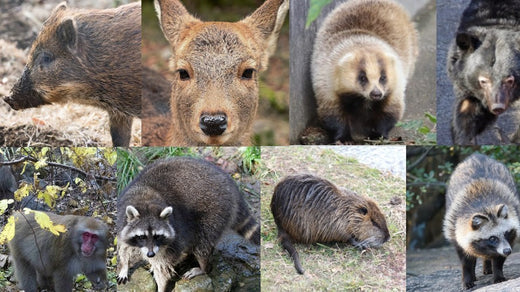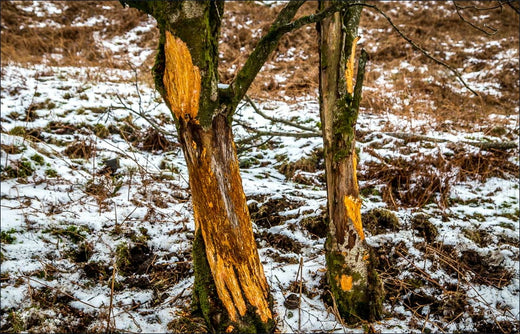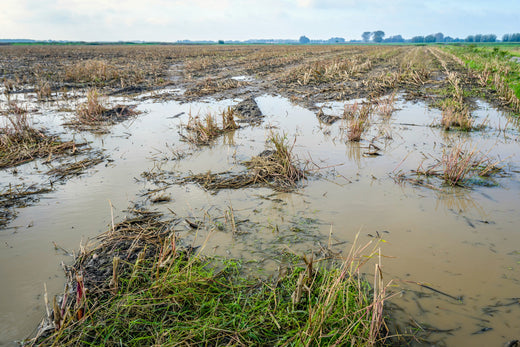In 2019, the amount of crop damage caused by wild birds and beasts was about 15.8 billion yen. Although the amount of damage has decreased year by year, the damage caused by wild animals is still serious. In order to stop the damage, there is a limit to the measures that can be taken by individuals, and efforts by groups and communities are essential.
In this article, we will explain the current situation and types of animal damage based on the latest data. In addition, we also introduce specific countermeasures, so please refer to them.
What is animal damage?
Wild boars, deer, bears, monkeys, rats, and other wild animals cause harm to animals.
It may also refer to harm caused by pets that are poorly managed by their owners. Although the term is used in a wide range of ways, the types of animal damage include the following.
1: Agricultural damage
Agricultural damage is the first to be taken up as animal damage. by wild animals,
- can eat crops
- fields are dug up
- A hole is made in a vinyl house
It refers to direct and indirect damage to agriculture.

Source: Ministry of Agriculture, Forestry and Fisheries website
According to the announcement by the Ministry of Agriculture, Forestry and Fisheries, crop damage caused by birds and beasts in 2020 amounted to approximately 15.8 billion yen. The amount of damage increased by about 20 million yen compared to the previous year (0.2% compared to the previous year). Although the amount of damage has increased slightly, compared to 23.9 billion yen in 2010 when the amount of damage peaked, it can be said that it is on a downward trend year by year.
In addition, the damaged area was about 48,000 ha, a decrease of about 3,000 ha compared to the previous year (down 7% from the previous year). The amount of damage was about 458,000 tons, a decrease of about 38,000 tons from the previous year (down 8% from the previous year). This is due to the fact that the Ministry of the Environment's project for capturing wild animals under designated management has begun to produce results, and the fact that harmful capture other than hunting is on the rise.
However, the damage amount of over 15 billion yen has remained at a high level for many years. It should be noted that this data does not include damages other than crops such as hobbies and home gardens. For example, in rural areas, there are cases where food is produced as part of daily food and community communication (exchange of agricultural products, etc.), and the amount of damage to such agricultural products is often not recorded.
Even if we take countermeasures against wild animals, if there is no community, we are forced to deal with them individually, so the reality is that we fall behind. It is also worth mentioning that due to the aging of farmers, the burden of animal damage control is increasing.
2: Forest damage
Forest damage is the damage caused by wild animals to the trees themselves and the destruction of the ecological balance unique to Japan in forests.

Source: Forestry Agency website
According to survey data on forest damage caused by wild birds and animals by the Forestry Agency, the forest damage area caused by major wild birds and animals in 2019 was about 4.9ha. This has decreased from about 5.9ha in the previous year, and has been on a decreasing trend since peaking at 9.0ha in 2014.
However, deer damage to forests is still serious. Deer's favorite food is various plants. They eat a wide variety of plants, not only grass and leaves, but also bark when food is scarce. It eats up all the plants in the area, and sometimes does enough damage to change the vegetation balance of the mountains.
About 3,500 hectares of forests were damaged by deer in 2019. They account for about 70% of forest damage caused by wild birds and animals, and the damage has expanded greatly, with the distribution area expanding about 2.5 times in the 36 years until 2014.
3. house damage
Damage to houses means that wild animals invade houses and cause damage such as defacement. It is a well-known story that raccoon claw marks were found on precious cultural assets at Byodo-in Phoenix Hall and Kiyomizu-dera Temple.
In recent years, there have been many reports of raccoons and palm civets expanding their habitat even in urban areas, hiding in attics and causing damage to houses.
Recently, there was a case where the grounds of Echizen Kaga Kaigan Quasi-National Park in Hashidate-cho, Kaga City were damaged by wild boars and the lawn was dug up. It can be said that the difficulty of countermeasures against wild animals is that damage occurs not only to the buildings themselves, but also to the landscape.
4. Human damage
Among animal damage types, human damage refers to direct or indirect damage to humans from animals.
There are direct damage such as being bitten by an animal and being injured, and indirect damage caused by an animal carrying pests or diseases. As for indirect damage, for example, in the last 10 years, there has been a nationwide increase in the number of people who go hiking, camping, mountain stream fishing, or work in the forests and have been bitten by Yamabiru. increase. It has been pointed out that this is due to the fact that wild boars that Yamabiru stick to have more opportunities to appear near human settlements in search of food.
As a result of the spread of the behavior of wild animals that serve as transporters, it is thought that the habitat range of Yamabiru is also expanding, and it has been pointed out that the damage caused by Yamabiru has increased as a result.
What should I do? 3 steps of animal damage control
As mentioned above, there are various types of animal damage, but for those involved in agriculture and forestry, animal damage is a matter of life and death.
Many people are confused because they do not understand the basic measures against animal damage, but the basic procedure for animal damage control is the same regardless of the case. Here, we will explain the basic policy of animal damage control by dividing it into three steps.
Step 1: Create a Group
Animal damage control can be more effective by working in a group than by working alone. It may seem obvious, but it is more efficient and effective to create a group and take measures rather than dealing with many prey and areas alone. First of all, it is possible to create a group with a small number of people.
Also, no matter how hard a small number of people in the village work hard, the effect will not be increased, and the burden will be concentrated and it will not last long. Let's increase the number of participating members in the group with the goal of 70% or more of the area working.
[Examples of local governments working on animal damage control]
Not only groups and regions, but also local governments are actively taking the lead in animal damage control. In Tsushima City, Nagasaki Prefecture, there is a lot of animal damage caused by deer, and forest damage is particularly serious. Therefore, we have adopted measures that involve the government and residents working together, including a bounty system. A project to subsidize the use of traps for catching deer has recently started. As a subsidized project to reduce damage to forests, this is a pioneering case in Japan, and it is one of the good models for working on animal damage control.
Step 2: Improving the local environment to avoid attracting pests
As more members become aware of local issues as their own, let's work together to improve the environment so that we don't attract vermin.
Specifically, it is to prevent the feeding of vermin. Most of the time, animals come to human settlements in search of food. Isn't it an environment where animals can find food when they come to the village even if humans don't intend to?
It is important to eliminate the environment in which animals are unknowingly fed with food. For example:
- Leftovers such as fly flies (2nd ear) after harvesting, crop residue, leftover food, etc.
- There are free fruit trees (unharvested chestnuts, persimmons, etc.)
- There are always offerings in the grave
- There are many abandoned farmlands that are not managed (there are crops to feed on, and there are environments where beasts can safely approach human settlements while hiding themselves).
Not only do we stop leaving kudzu vegetables and raw garbage, but we also burn off rice paddies and stocks as soon as possible after harvesting. Also, try to reduce the amount of food for animals as much as possible, such as not cutting the grass before the season (winter) when there is less food for wild animals. If there is not enough food to match the population, the beast will not grow any more.
It would be a good idea for countermeasures members to check possible baits in the village and create a checklist. Then, based on the created checklist, you can actually walk in and around the village and farmland and conduct field checks such as abandoned fruit trees, garbage disposal, damage status, etc., and you will be able to make the countermeasures more concrete.
In addition, share the information obtained from the activities with the local residents, and take time to work on them so that each of them can see it as their own problem. If not only the main group and the affected residents but also the surrounding residents work together and work together, a sense of camaraderie and solidarity will be created, and it will be possible to further develop animal damage control measures. .
Step 3: Fencing and population control
It is important to properly maintain the protective fences and protective nets, not the end after they are installed. Even if you set up a fine fence, if you abandon management and maintenance after that, depending on the place, people will be farther away, and there will be more hiding places for animals. It is important to minimize such areas as much as possible.
In addition, it is necessary to manage the population of pests that have increased excessively by capturing them. To capture wild birds and beasts, it is required to obtain a hunting license and use legal hunting equipment to capture them. The hunting equipment that can be used is determined for each hunting license, and if you want to capture using traps, box traps, enclosure traps, etc., it is necessary to obtain a trapping license.
summary
When taking measures to prevent damage caused by pests, it is important to first form a group for countermeasures and to know the factors that cause damage.
On top of that, it is necessary to take measures to deal with the damage factors. We hope that the above basic guidelines will help you reduce the damage caused by vermin.

 箱罠
箱罠
 くくり罠
くくり罠
 パーツ類
パーツ類
 電気柵
電気柵
 自作キット
自作キット
 防獣グッズ
防獣グッズ
 監視カメラ
監視カメラ




 box trap
box trap
 tying trap
tying trap
 enclosure trap
enclosure trap
 Prevention and avoidance goods
Prevention and avoidance goods
 electric fence
electric fence
 trap surveillance camera
trap surveillance camera
 transportation goods
transportation goods
 Trap detection sensor
Trap detection sensor
 hunting supplies
hunting supplies
 hunting books
hunting books
 Anti-bird goods
Anti-bird goods
 Agricultural materials/machinery
Agricultural materials/machinery
 boar
boar
 deer
deer
 Kyon
Kyon
 monkey
monkey
 raccoon
raccoon
 Badger
Badger
 palm civet
palm civet
 raccoon dog
raccoon dog
 nutria
nutria
 mouse or rat
mouse or rat
 Mole
Mole
 bear
bear
 pigeon
pigeon
 Crow
Crow







